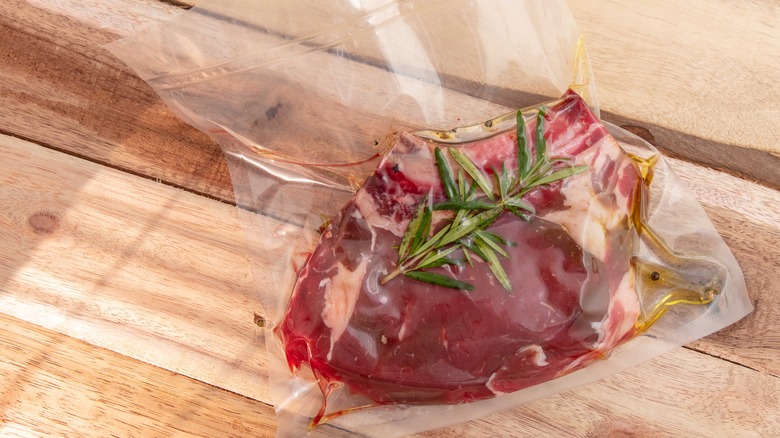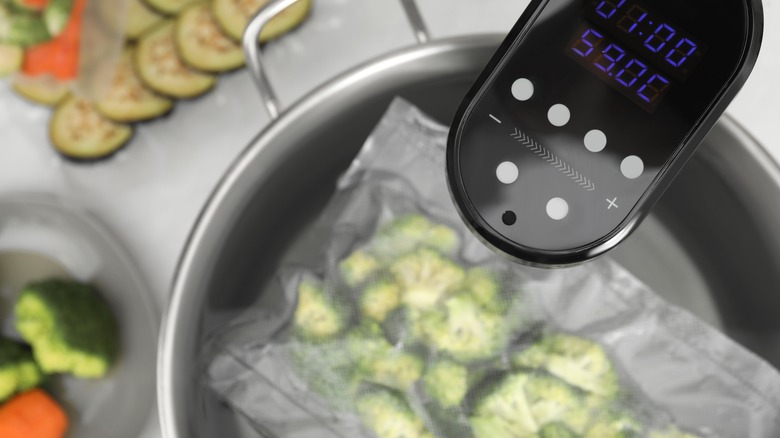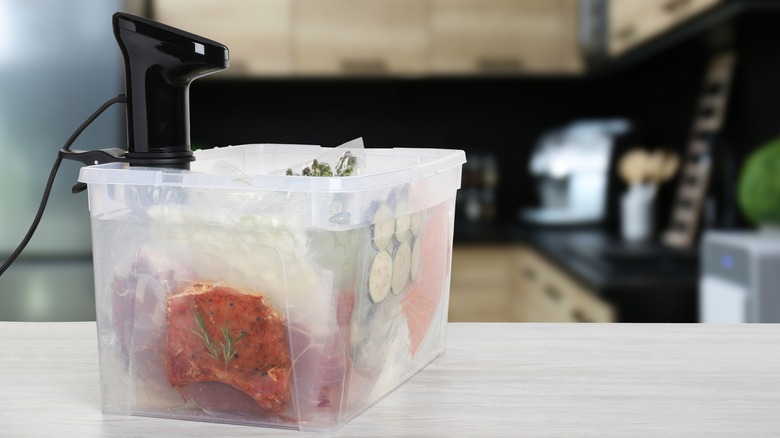How Does A Sous Vide Work And Is It Worth It?
With today's enormous scope of culinary gadgets and tools, many cooking methods are available. Yet, in the last few years, few have enamored chefs quite like sous vide. You'll find trendy ramen shops employing it on their eggs, and high-end steakhouses using it to perfect their beef. Boosted by its foreign name, it's easy to ask — what's the fuss all about?
Well, at its most fundamental, sous vide is pretty straightforward. It involves a water bath that's precisely heated to a specific degree. Food is then hermetically sealed in a plastic bag, placed into the liquid, and continuously moved. As a result, the contained matter evenly cooks from all sides, and it's impossible to overcook in such an ambient environment. Not only does this enable hands-off cooking, but such a heating approach can also achieve distinct textures. You will need to invest in some techie-looking contraptions, but if you're after either convenience or perfectionism, the device pays off.
A sous vide prepares foods with precision
Firstly, the term refers to the sealed bag setup, rather than the preparation method itself. Translating from French to "under vacuum," it's the tight bagging of the food in plastic that gave rise to the method. Invented for hospital cooking in 1968, it initially started as a method of convenient packaging. However, a few years later, Parisian chefs started tinkering with the method for roasted beef and foie gras, noting its impressive effects on texture.
Indeed, this merging of protection and heat remains a cornerstone of the technique. Unlike other cooking methods — whether it be grill, stove, or pot — there's no contact between heat source and food. You won't need any fat, and moisture that's drawn out during circulation will remain inside the sealed bag.
Additionally, sous vide gently increases temperature, until it reaches a desired target. From then on out, it maintains a consistent level of heat. It's a gentle, wonderfully stable manner of cooking, that's completely different from any other cooking method. It's physically impossible to overcook foodstuffs, lending a far more hands-off, and less risky, cooking process. A bit like an air fryer or hot pot, you can set your desired setting, and then walk away from the device, letting it quietly whir away in the background.
A sous vide crafts tender foods
Due to the sous vide's sealed nature, the texture of foods is impacted in a distinct manner. The interior starts to heat through but without loss of any moisture. This is especially prominent with proteins such as chicken and pork, which take on a completely new quality with the preparation method. You'll be able to cook an especially tender chicken breast or a wondrously succulent pork shoulder. You can even put your sous vide to work with bacon, rendering the cured meat in its own fat. Perhaps the most beloved use with sous vide is steak — it's the key to attaining a perfect medium rare interior.
Such precision also makes sous vide popular with delicate foodstuffs, like soft-boiled eggs, or seafood, such as lobster and fish. Especially if there's lots of multitasking in the kitchen, you don't have to worry about ruining such dishes. Not to mention, sous video doesn't require any fat, another advantage of the method.
Understandably, the food that comes out of a sous vide doesn't have any color or caramelization — the advantages of some direct heat. So to compensate, many chefs finish the sous vide foods with a sear or on the grill. A bit like the reverse sear method for steak, it's a manner of attaining incredible color without the worry of overcooking the interior. However, keep in mind this final caramelization won't have quite the same intensity as with traditional methods.
A sous vide requires investment in gear
To attain the right balance of temperature and circulation, as well as ensure that everything is perfectly hermetically sealed, sous vide requires several pieces of equipment. It's introducing a whole new cooking method to the kitchen, which also means additional counter space. Thankfully, the contraptions have gotten increasingly accessible, taking the sous vide from the fine-dining kitchen to the home. Plus, there are a few ingenious hacks to alleviate the financial commitment.
You can use the water bath method of closing bags if you don't have a vacuum seal for your sous vide. With a stash of large ziplocks and a large pot, that's a sous vide requirement alleviated. Additionally, many modern sous vide setups work with any container for the water bath, so that's another component you might already have at home. As a result, the main purchase is the programmed immersion circulator, which can cost hundreds of dollars for a nice model — potentially not worthwhile for budget chefs.
Furthermore, you'll need some practice using the device. Some foods are best judged by eye — like the color of shrimp or the flake of a fish. So programming the process can prove tricky. The machine can also increase the risk of undercooking; make sure to verse yourself in minimum temperatures for consumption. Always double-check there's no leakage, too — you wouldn't want raw chicken juice infiltrating the water. So, just keep such trials and errors in mind, and you'll unlock a new, innovative preparation method.



